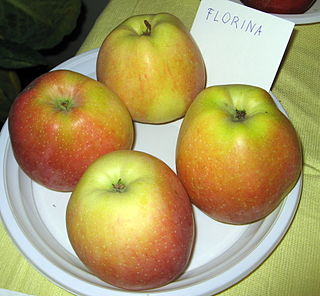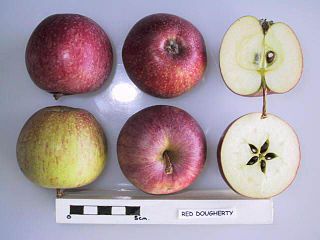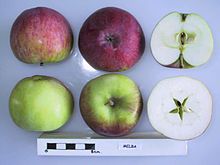
The McIntosh, McIntosh Red, or colloquially the Mac, is an apple cultivar, the national apple of Canada. The fruit has red and green skin, a tart flavour, and tender white flesh, which ripens in late September. It is considered an all-purpose apple, suitable both for cooking and eating raw.

A cooking apple or culinary apple is an apple that is used primarily for cooking, as opposed to a dessert apple, which is eaten raw. Cooking apples are generally larger, and can be tarter than dessert varieties. Some varieties have a firm flesh that does not break down much when cooked. Culinary varieties with a high acid content produce froth when cooked, which is desirable for some recipes. Britain grows a large range of apples specifically for cooking. Worldwide, dual-purpose varieties are more widely grown.

Mammea americana, commonly known as mammee, mammee apple, mamey, mamey apple, Santo Domingo apricot, tropical apricot, or South American apricot, is an evergreen tree of the family Calophyllaceae, whose fruit is edible. It has also been classified as belonging to the family Guttiferae Juss. (1789), which would make it a relative of the mangosteen.

Malus sieversii is a wild apple native to the mountains of Central Asia in southern Kazakhstan. It has recently been shown to be the primary ancestor of most cultivars of the domesticated apple. It was first described as Pyrus sieversii due to its similarities with pears in 1833 by Carl Friedrich von Ledebour, a German naturalist who saw them growing in the Altai Mountains.

Paula Red Discovered by Lewis Arends near Sparta, Michigan in 1960. It was near other wild apple seedlings growing near a ravine where apples had been dumped. Tests run by experts show its parents to be McIntosh and Duchess. Paulareds mature after Duchess and before McIntosh. Hilltop Nurseries held the patent for Paulareds. They had a contest to name the apple with Paulared being chosen to honor “Luke” Arends's wife Pauline

The Rome apple is a cooking apple originating near Rome Township, Ohio, in the early 19th century. This apple remains popular for its glossy red color and for its utility in cooking.

Belle de Boskoop is an apple cultivar which originated in Boskoop, Netherlands, where it began as a chance seedling in 1856. Variants include Boskoop red, yellow and green. This rustic apple is firm, tart and fragrant. Greenish-gray tinged with red, the apple stands up well to cooking. Generally Boskoop varieties are very high in acid content and they can contain over four times the vitamin C of Granny Smith or Golden Delicious.

The Redstreak, also spelt Redstrake, Red Streak or Red-streak, is or was a very old variety of cider apple formerly commonly planted in England.

Envy is a trademarked brand of the Scilate apple variety. Scilate is the result of a cross between Royal Gala and Braeburn. It was developed in New Zealand by HortResearch, submitted for a patent in 2008 and patented in 2009. Field tests were done in the countries of New Zealand, the United Kingdom, France, and the US. Some trialing was done in Italy with organic cultivation.

Malus niedzwetzkyana, or Niedzwetzky's apple, is a kind of apple native to certain parts of China, Afghanistan, Kazakhstan, Kyrgyzstan, and Uzbekistan noted for its red-fleshed, red-skinned fruit and red flowers. Some botanists consider it a distinct species, while others have argued it is simply an unusual variety of the common apple, Malus pumila.

'Surprise' is a pink-fleshed apple that is the ancestor of many of the present-day pink/red-fleshed apples bred by American growers.
Applecrabs are various hybrids between crabapples and apples. They are bred for varying reasons, including disease resistance and use in cold climates because they are often hardier than apple trees and their fruit has the good eating qualities of apples.

Florina which is also called Querina, is a French cultivar of domesticated apple, that has combined traits of the Jonathan, Golden Delicious and Rome apples, and was developed in Angers, France, by the "Station de Recherches d'Arboriculture Fruitiere". Although developed in France its ancestry is entirely American.

Winston is an English cultivar of domesticated apple which was first named Winter King because of its availability in the winter, but was renamed as Winston in 1944 or in 1945, after Winston Churchill.

The 'Prima' apple is one of the modern disease resistant cultivars of domesticated apple which was bred by the PRI disease resistant apple breeding program in 1958. The disease resistance against apple scab has since been broken.

'Dougherty' was a New Zealand cultivar of domesticated apple, which was grown mainly for export to the United Kingdom, from which a red coloured mutation is marketed today as 'Red Dougherty'. 'Dougherty' produces medium-sized fruits in late season, the skin background is greenish-yellow and flushed with some red. The flesh is yellowish with a sweet flavour.

Gascoyne's Scarlet is an English cultivar of domesticated apple which is used to produce apple juice with a pink color. Is named after its developer, Mr. Gascoyne of Bapchild near Sittingbourne, Kent, England, who bred it before 1871.

Cornish Aromatic is an apple cultivar with a crisp, nut-like aromatic flavour that was first recorded in Cornwall in 1813.

Cosmic Crisp is an American apple with the variety designation 'WA 38'. Breeding began in 1997 at the Washington State University (WSU) Tree Fruit Research and Extension Center in Wenatchee, Washington, and was initially overseen by Bruce Barritt. Kate Evans completed the research after Barritt's retirement from WSU.
The Poveshon, sometimes "Povershon", is an 18th-century American cider apple, primarily used for the production of apple cider. Grown in New Jersey before and after the American Revolution, it became obsolete by the 20th century as the cider industry in the state declined. It is considered lost, though it has possibly been rediscovered.




















